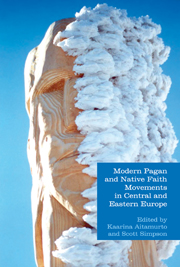Book contents
- Frontmatter
- Contents
- Contributors
- 1 Introduction: Modern Pagan and Native Faith Movements in Central and Eastern Europe
- Part I Overviews
- Part I Country Studies
- 6 Contemporary Paganism in Lithuanian Context: Principal Beliefs and Practices of Romuva
- 7 The Dievturi Movement in Latvia as Invention of Tradition
- 8 Polish Rodzimowierstwo: Strategies for (Re)constructing a Movement
- 9 Ukrainian Paganism and Syncretism: “This Is Indeed Ours!”
- 10 Russian Rodnoverie: Six Portraits of a Movement
- 11 Czech Neopagan Movements and Leaders
- 12 Neopaganism in Slovenia
- 13 Bulgarian Society and the Diversity of Pagan and Neopagan Themes
- 14 Romanian Ethno-Paganism: Discourses of Nationalistic Religion in Virtual Space
- 15 Neopaganism in Hungary: Under the Spell of Roots
- 16 Neopaganism in the Mari El Republic
- 17 A Neopagan Movement in Armenia: The Children of Ara
- Part III Thematic Studies
- Bibliography
- Index
6 - Contemporary Paganism in Lithuanian Context: Principal Beliefs and Practices of Romuva
from Part I - Country Studies
- Frontmatter
- Contents
- Contributors
- 1 Introduction: Modern Pagan and Native Faith Movements in Central and Eastern Europe
- Part I Overviews
- Part I Country Studies
- 6 Contemporary Paganism in Lithuanian Context: Principal Beliefs and Practices of Romuva
- 7 The Dievturi Movement in Latvia as Invention of Tradition
- 8 Polish Rodzimowierstwo: Strategies for (Re)constructing a Movement
- 9 Ukrainian Paganism and Syncretism: “This Is Indeed Ours!”
- 10 Russian Rodnoverie: Six Portraits of a Movement
- 11 Czech Neopagan Movements and Leaders
- 12 Neopaganism in Slovenia
- 13 Bulgarian Society and the Diversity of Pagan and Neopagan Themes
- 14 Romanian Ethno-Paganism: Discourses of Nationalistic Religion in Virtual Space
- 15 Neopaganism in Hungary: Under the Spell of Roots
- 16 Neopaganism in the Mari El Republic
- 17 A Neopagan Movement in Armenia: The Children of Ara
- Part III Thematic Studies
- Bibliography
- Index
Summary
INTRODUCTION
Scholars trying to describe the contemporary reappearance of the pervasiveness of religiosity across the globe have used terms such as religious “resurgence” (Robertson and Chirico), “desecularization” (Berger), or “deprivatization” (Casanova). In order to characterize this religious situation, such terms as the religious individualization process have been used for when a “personal belief” replaces the “official religious models” that have predominated before.
Many new religious movements can be examined as offering an alternative to the mainstream forms of religion. In the West, a disappointment with the progress of civilization revealed itself in the second half of the twentieth century. It induced a fragmentation of the cultural, ethnic, and religious center which was manifested in ethnic and belief-related conflicts, and it did not increase the integration of the world and humanity contrary to many predictions. Such sociocultural processes strengthened the formation of alternative movements which were oriented to variously understood searches for spirituality and the establishment of new communities. Some manifestations of an orientation toward localness in these movements have also been visible: the revival of traditionalistic and nationalistic ideas, the (re)construction of local ethnicities and nature-based spiritualities, and attempts to reconstruct traditional pre-Christian religions.
Alternative religious movements (new religious movements and the New Age milieu) mostly emerged in post-Soviet societies after the collapse of the Soviet Union, when a strong demand for spirituality and spirituality-oriented communities in its former territories had arisen.
- Type
- Chapter
- Information
- Publisher: Acumen PublishingPrint publication year: 2013

